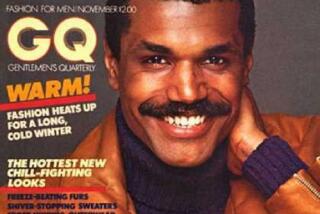Surprise! Scantily Clad Stars Still Sell Magazines
- Share via
Left to right on the newsstand, the gallery looks like this:
Julianna Margulies, of NBC’s “ER,” reaches behind to unfasten (or possibly to fasten) her bra, on the August issue of Esquire.
Renee Zellweger, who appeared opposite Tom Cruise in “Jerry Maguire,” spills out of her Prada dress on the September cover of Vanity Fair.
The increasingly exposed (no pun intended) Mira Sorvino amply fills her black camisole, bra straps in plain view, to lure readers to the August issue of GQ.
The Monday morning mail echoes the theme. On the September issue of George, a birthday-suited Kate Moss portrays Eve in the garden, presumably to herald an inside story on the “20 Most Fascinating Women in Politics,” a roundup that dares to include Ellen DeGeneres’ gal pal, Anne Heche--pictured in a lacy black bodysuit, naturally.
Set against a backdrop of lurid red, Sigourney Weaver looks as if she’s trying to pull off her tight-fitting tunic on the September issue of Movieline (“The new ‘Alien’ picture is pretty kinky,” she says in a cover line), and the actress poses even more provocatively inside, stiletto heels and all.
The September Los Angeles shows off a pensive-looking Michelle Pfeiffer in a lush black gown with a very low neckline.
What’s going on here (as if we didn’t know)?
“Well, yeah, it absolutely seems that the old adage holds--sex still sells,” said Cyndi Stivers, editor in chief of Time Out New York, one of whose top sellers last year was its nudism issue, where the judicious placement of display type concealed body parts on the cover. “I don’t know when it will stop, but so far there’s no end to it.”
Those who work on the editorial side of magazines say that racier images have proliferated as the celebrity treadmill hums at ever-faster speed. That is, as certain actors and entertainers achieve a numbing familiarity from appearances in one magazine and talk show after another, often saying nothing of substance in the process, other personalities can stand out in the celebrity gallery, as well as on crowded newsstands, by wearing less and less. What’s more, magazine editors suggest, because many stars reveal so little in interviews, readers have come to expect more of them to wear less, if only to maintain the interest level.
How familiar are some celebs? This summer alone, a clothed Julia Roberts has graced the covers of Harper’s Bazaar (June), InStyle and Mademoiselle (both July) and Good Housekeeping (September). In addition, this week she’s been on the covers of Time Out New York and Entertainment Weekly, clutching her “Conspiracy Theory” co-star, Mel Gibson, who strides the beach alone on the new September issue of US.
“The reader maybe can get a great interview from a star,” Stivers said, “or in an era when you can freeze a nude frame in a movie on your VCR, some would like to hold a sexy image in their hand.”
*
The enduring popularity of Playboy and Sports Illustrated’s annual swimsuit issue has underscored the appeal of beautiful women on the magazine page. But among other publications the current plethora of sexy portraits dates to more recent years.
More than many other magazines, US has turned up the heat with its celebrity portraits, especially those taken by chief photographer Mark Seliger, whose credit line in the sexy September fashion shoot featuring Neve Campbell, of TV’s “Party of Five,” is almost as large as the actress’ name.
In the book “Crazy Sexy Cool” (Little, Brown), a 1996 photo collection that includes many of Seliger’s striking US portraits, writer David Wild said he had long noticed that “there is something about Mark Seliger in particular that seems to make famous people want to disrobe.” Seliger himself said he’s trying to show “the intimate side of some very public people. . . . The truth is people become more interesting when they agree to let their guard down and let us unveil them a bit.”
Owned by editor in chief Jann S. Wenner, the man who gave rock ‘n’ roll strong visual definition in the pages of his Rolling Stone during the ‘70s and ‘80s, US long ago shed the People-wannabe rap and has parlayed its often sexually charged images of the fresh and famous into one of the biggest gains on newsstands. Between 1986 and 1996, the magazine grew its monthly sale by 109,000 copies, raising its lucrative single-copy total to about 485,000.
Arthur Cooper, editor in chief of GQ, found his biggest seller of 1994 in the actress Geena Davis, who was blond at the time and wore an Armani suit, opened at the hips to reveal her navel, an erogenous zone that was snapped up by about 400,000 readers.
Vanity Fair’s biggest newsstand hit in its history--607,000 copies sold--was published a year later. The special Hollywood issue featured a three-panel cover of beautiful actresses in undergarments; the Hollywood-panoply idea was repeated in 1996 with fully clothed actors, as well as last spring, when three panels of starlets in slinky evening wear helped make the 384-page issue Vanity Fair’s fattest ever (to be exceeded by October’s “New Establishment” issue).
*
At the same time, sex sells at a needy time for the magazine industry, which can no longer count on full-price sales at newsstands and supermarket checkouts for an abundance of riches. Between 1986 and 1996, as VCRs became commonplace and cable-TV channels multiplied, the 100 leading consumer magazines collectively declined 35% in the number of copies they sold at newsstands--more than 22 million copies per issue--according to Capell’s Circulation Report, an industry newsletter.
“I wish I didn’t have to do celebrity covers,” said Cooper, who scored one of his bigger sellers of 1996 with the actress Elisabeth Shue, posed seductively on the October cover in nothing but a cashmere sweater. “But you know damn well that, if you have to sell 300,000 copies a month on newsstands, you’re happy to have the attention.”
*
Murdoch Speaks: The Sept. 1 issue of National Review, the conservative monthly, presents the world according to Rupert Murdoch. In an excerpt from a speech before a recent Forbes conference, the News Corp. chairman said the danger he sees “is not external, not foreign and not military. It is operating within our own societies, right under our noses. Let me put it in this way: If socialism is dead, why won’t it lie down?”
* Paul D. Colford is a columnist for Newsday. His e-mail address is [email protected]. His column is published Thursdays.
More to Read
The biggest entertainment stories
Get our big stories about Hollywood, film, television, music, arts, culture and more right in your inbox as soon as they publish.
You may occasionally receive promotional content from the Los Angeles Times.










